
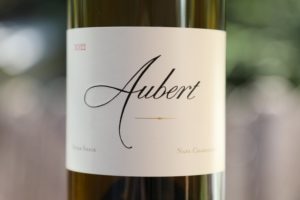
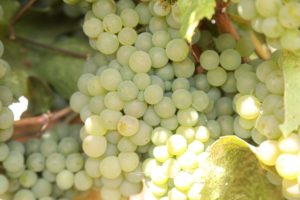 Aubert Wines was founded by Mark and Teresa Aubert with the first vintage in 2000 focusing exclusively on Chardonnay and Pinot Noir. The first single vineyard wine bottled under Aubert was a 2000 Chardonnay from the now iconic Ritchie Vineyard in Sonoma County. While not the first to vineyard designate a Chardonnay from this vineyard, (that honor goes to winemaker Greg La Follette), arguably the Aubert bottlings helped gain recognition for this site. Today a number of premium wineries now produce Ritchie Vineyard designate Chardonnay. And the first Aubert Pinot Noir was from Reuling Vineyard in 2002.
Aubert Wines was founded by Mark and Teresa Aubert with the first vintage in 2000 focusing exclusively on Chardonnay and Pinot Noir. The first single vineyard wine bottled under Aubert was a 2000 Chardonnay from the now iconic Ritchie Vineyard in Sonoma County. While not the first to vineyard designate a Chardonnay from this vineyard, (that honor goes to winemaker Greg La Follette), arguably the Aubert bottlings helped gain recognition for this site. Today a number of premium wineries now produce Ritchie Vineyard designate Chardonnay. And the first Aubert Pinot Noir was from Reuling Vineyard in 2002.
Aubert is one of Napa Valley’s remarkable success stories. Mark grew up near St. Helena; his father Dr. Richard Aubert, served in the Korean War (died 2024) was a pharmacist and owned Calistoga Pharmacy located at 1373 Lincoln Avenue, the handsome corner building that was the old Calistoga National Bank building (the bank itself was organized in 1909), was home for 17 years to Bella Tootsie, a boutique shoe store run by Celeste Navone (Navone Family Wines), for about 6 years housed the tasting room for Huge Bear Wines and currently is the home to EV Floral Design.
Richard was living in Rancho Cordoba (near Sacramento) and moved his family to Napa Valley in 1969. In 1974 he purchased a hillside piece of property in the hills near St. Helena in what is now the Spring Mountain appellation and planted Cabernet Sauvignon. He bottled Cabernet Sauvignon and Petite Sirah as Rockland Road Cellars named after the road his property was located on. Both grapes and olive trees on his property were originally planted in the 1880s. This vineyard is not far from the historic Chateau Chevalier, on Spring Mountain Vineyard’s property. Rockland Road Cellars produced their first Petite Sirah in 1989. From online research, it appears Rockland Road Cellars produced their final vintages in the early 2000s.
According to an article dated April 4, 1974 in the St. Helena Star Richard was initially affiliated with St. Helena Smith’s Pharmacy, a pharmacy that remarkably is still in business having been founded in downtown St. Helena in 1874. Aubert graduated from St. Helena High School and then graduated from Fresno State in 1985 with a degree in enology and a double minor in viticulture and chemistry.
His first winery job in Napa Valley was as an enologist at Rutherford Hill followed by an assistant winemaker at Monticello Vineyards where he produced their first lees-stirred Chardonnay in 1988. In 1989 he was hired by winemaker Helen Turley to work at Peter Michael Winery in Knights Valley of neighboring Sonoma County. By age 28 he was their head winemaker. In 1989 he joined Colgin and then consulted for others including Sloan, Bryant Family and Futo Estate. 2009 was the last year he consulted; he has since focused entirely on Aubert Wines.
Similar to a number of premium producers who after starting their brands at Laird Family Winery, and now own physical wineries in Napa Valley, Aubert previously made wine at Laird Family. In 2010 Aubert acquired the former August Briggs Winery (2 acres). August Briggs Winery was originally built in 2003 by Joe Briggs (like Aubert, also a Fresno State graduate) and opened in 2004. After the transition in ownership, Aubert significantly remodeled the winery. And after selling the winery and property to Aubert, August Briggs moved their production to neighboring Sonoma County while continuing to operate a small tasting room in downtown Calistoga.
In 2015, their then next door neighbor, Brian Arden opened their own winery. In 2025 Aubert acquired the 2.25 acre Brian Arden property and winery but not the Brian Arden brand and will use this second production space. In 2021, the Four Seasons managed resort opened on the other side of the Silverado Trail from Aubert. While located directly next to vineyards, Aubert Winery is located within the southern limit of the city of Calistoga. And while the northern part of Napa Valley is known for its warm growing season and wineries who focus on red wines, Aubert is not the only ‘up valley’ winery focusing on Pinot Noir and Chardonnay from non Napa Valley vineyards; reference Failla Vineyards, Morlet and Chateau Boswell.
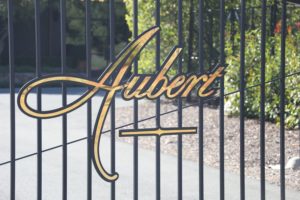

 As of our latest update to this review, Aubert makes wines from three vineyards in Napa Valley, including their estate owned 7-acre Sugar Shack property in the north west part of the Rutherford appellation planted to Chardonnay by David Abreu in 2009. They also own three acres adjoining this parcel on its eastern boundary. Nearby winery neighbors include Dana Estate and Cathiard Estate. Chardonnay is rarely grown in Rutherford these days; for reference, two other Chardonnay plantings to mention in this appellation are Star Vineyard located behind La Luna Market and the small block of Chardonnay at Staglin Vineyard. And the other Napa Valley Vineyards Aubert works with are Hyde Vineyard and Hudson Vineyard in Carneros.
As of our latest update to this review, Aubert makes wines from three vineyards in Napa Valley, including their estate owned 7-acre Sugar Shack property in the north west part of the Rutherford appellation planted to Chardonnay by David Abreu in 2009. They also own three acres adjoining this parcel on its eastern boundary. Nearby winery neighbors include Dana Estate and Cathiard Estate. Chardonnay is rarely grown in Rutherford these days; for reference, two other Chardonnay plantings to mention in this appellation are Star Vineyard located behind La Luna Market and the small block of Chardonnay at Staglin Vineyard. And the other Napa Valley Vineyards Aubert works with are Hyde Vineyard and Hudson Vineyard in Carneros.
All of the other vineyards are located in neighboring Sonoma County including four vineyards under their ownership. Forestville factors prominently in their vineyard locations including two neighboring estate properties: Lauren which was previously an apple orchard is named in homage to their daughter and was their first estate vineyard planted in 1999, and CIX is named after the Roman numeral in honor of this particular vineyard map’s parcel number (109). And Park Avenue and Powder House, named after a nearby building which used to store gunpowder. Look for the number of estate vineyards to continue to grow.
Aubert purchases grapes from Eastside, UV and UV-SL, both planted by their former vineyard manager Ulises Valdez Sr (died in 2018). Aubert harvests remarkably low yields from his vineyards (typically less than 2.5 tons per acre), in part resulting in concentrated wines. And Aubert currently produces eight different Chardonnays and three Pinot Noirs.
Aubert’s Chardonnay is typically in the 15% alcohol range but with acidity that balances the higher alcohol, so the wines never show as overripe or ‘hot’. Still they are fruit forward, built with texture in mind and showcase a ‘full’ expression of this variety and resulting site, both on the bouquet and the palate. In the cellar, individual clones are fermented and aged separate from one another until prior to bottling. Their Chardonnay is always barrel fermented with no stirring of the lees, while full malolactic fermentation is desired and allowed to occur naturally. Regardless of site, the winemaking practices are the same.
And the indigenous (native yeast) ferments are cold and slow, sometimes taking up to 6 months. We first experienced this slow style of fermenting Chardonnay when we visited Kongsgaard Winery years ago. The Aubert Chardonnay is aged in up to 75% new French oak barrels for about 10 months before the wine is transferred into tall fully jacketed stainless steel tanks for the remainder of their aging. Their Chardonnays are unfiltered so achieving natural clarity is important; the wine is carefully extracted and separated from the lees in barrel. And they are not manually fined, rather the fining is done slowly through gravity over time.
The Aubert Pinot Noir is also fermented using indigenous yeast, whole cluster (stems are not removed) and post fermentation, the wine undergoes extended maceration.
Select Wines
Chardonnay
If one were to invite some of Napa Valley’s top Chardonnay producers to a tasting, Aubert would clearly take a seat at this coveted table. And you better extend the invite to some of California’s other acclaimed Chardonnay producers including Kistler, Marcassin and Peter Michael.
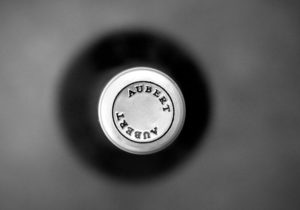 The 2022 Aubert Sugar Shack Chardonnay, Napa Valley is deep gold in color; the ripe, fruit driven, diverse, forward, rich and intense aromatics fully envelope the glass. This wine offers pronounced honeyed characteristics including honeycomb and honeysuckle, accompanied by creme Brule, toffee, caramel and orchard fruits including apricot, yellow peaches and nectarines. There are also plenty of tropical overtones, i.e., mottled bananas, baked pineapple, papaya and fully ripe yellow mango. And before you reluctantly pull away, citrus blossom and roasted hazelnut. Fleshy and oily, with plenty of weight but without any viscosity heaviness in terms of texture, this wine offers an ethereal character. On the palate there are intense flavors of pineapple, apricot, peach, toasted coconut, butterscotch and vanilla supported by an equally rich acidity. And while the intensity drops off on the finish, the flavors continue for quite some time and are perceived as a tangy sweetness. Like the other Aubert Chardonnays we have tried, this bottling is not shy; if this wine was a woman and she was to show up at a party dressed to kill, it would be in a stunning solid yellow Alexander McQueen blazer with matching pants, with the other accessories left to her discretion. All eyes would be on her.
The 2022 Aubert Sugar Shack Chardonnay, Napa Valley is deep gold in color; the ripe, fruit driven, diverse, forward, rich and intense aromatics fully envelope the glass. This wine offers pronounced honeyed characteristics including honeycomb and honeysuckle, accompanied by creme Brule, toffee, caramel and orchard fruits including apricot, yellow peaches and nectarines. There are also plenty of tropical overtones, i.e., mottled bananas, baked pineapple, papaya and fully ripe yellow mango. And before you reluctantly pull away, citrus blossom and roasted hazelnut. Fleshy and oily, with plenty of weight but without any viscosity heaviness in terms of texture, this wine offers an ethereal character. On the palate there are intense flavors of pineapple, apricot, peach, toasted coconut, butterscotch and vanilla supported by an equally rich acidity. And while the intensity drops off on the finish, the flavors continue for quite some time and are perceived as a tangy sweetness. Like the other Aubert Chardonnays we have tried, this bottling is not shy; if this wine was a woman and she was to show up at a party dressed to kill, it would be in a stunning solid yellow Alexander McQueen blazer with matching pants, with the other accessories left to her discretion. All eyes would be on her.
The 2016 Aubert Larry Hyde & Sons Carneros Chardonnay is deep gold in color. The bouquet sports an impressive depth of aromatics including a combination of both sweet and sour scents. These include honeycomb, chamomile, hard rock lemon candy, marshmallow, vanilla, apricot, peaches in light syrup, mango, walnut and toasted hazelnut. We didn’t try this wine upon release, but we suspect it hasn’t lost much of its aromatic stride at 8 years post vintage at the time of our tasting. Impressive. The palate offers the trademark ‘Aubert intensity’ with flavors of nectarine, pineapple, honey, lemon juice, juice from ripe and freshly pressed Golden delicious apples and pineapple. Mineral driven with an almost briny texture, this wine finishes richly flavored, emboldened by its equally affluent and bright acidity. Some might consider styles of Chardonnay as either black and white, referring to up front oak, butter and California sunshine or more Chablis style and restrained. This wine is not black or white, rather it is fully expressed in bright color, and is a generous helping of this variety. It is 15.2% alcohol with a light warmth felt on the back of the palate.
The 2021 Aubert UV-SL Vineyard Sonoma Coast Chardonnay is deep gold in color; the brightly lit, ripe and diverse bouquet offers aromas of candied ginger and orange peel, butterscotch, caramel, toffee, honeycomb, lemon meringue pie, baked pineapple, creme Brule, dried apricots, canned peaches, mango and ripe papaya along with tropical florals. Like all of Aubert’s Chardonnay’s the aromatics play a prominent role, but especially with this bottling. The richness of the fruit holds up well to the intensity and brightness of its acidity. On the palate there are flavors of yellow peaches, apricot, mango, yellow nectarines, honeycomb, apple pie and mandarin orange with a light note of hazelnut on the finish. Perhaps not expected, but most certainly present is a saline or briny sensation across the palate. And the extended finish continues to give in terms of flavor and brightness. This wine is sitting in a sweet spot right now, 3 years post vintage at the time of our tasting but clearly has the charisma to age very well. 15.0% alcohol.
The 2020 Aubert Powder House Chardonnay, Sonoma Coast is deep gold in the glass; the bouquet offers aromas of honeysuckle and honey, melon, pineapple, quince, vanilla, caramel, creme Brule, white toast, and roasted hazelnut. While perhaps not showcasing as much aromatic intensity as some of the other Aubert bottlings we have nosed, there is still a remarkable amount of layering, in terms of pleasure. This wine packs plenty of flavor and richness but perhaps its texture is perceived as being lighter, based on its agile and bright acidity. Its flavors include pineapple, apricot, yellow nectarine, peach, baked apple, tangerine, candied orange peel, ginger and a note of tarragon. And the lively acidity provides a generous lift on the rich finish. Mouth watering, each sip begs another one and before you know it the bottle has been emptied. This bottling from this particular vintage is highly worth seeking out.
Pinot Noir


 Pinot Noir is about 25% of Aubert’s production. Like their Chardonnay, these wines always score very highly with a very select group of critics who are allowed access into the “Aubert gate”, including Lisa Perrotti-Brown of The Wine Independent, Antonio Galloni of Vinous, James Suckling, The Wine Advocate and The Wine Spectator. In 2020, the Aubert Pinot Noir Sonoma Coast UV Vineyard earned the number two ranking in the Wine Spectator’s Top 100 List.
Pinot Noir is about 25% of Aubert’s production. Like their Chardonnay, these wines always score very highly with a very select group of critics who are allowed access into the “Aubert gate”, including Lisa Perrotti-Brown of The Wine Independent, Antonio Galloni of Vinous, James Suckling, The Wine Advocate and The Wine Spectator. In 2020, the Aubert Pinot Noir Sonoma Coast UV Vineyard earned the number two ranking in the Wine Spectator’s Top 100 List.
Starting with the 2022 bottlings of Pinot Noir, Aubert switched to bottles which are 30% lighter. For reference, wine bottles are the singular most significant impact in terms of a wineries’ carbon footprint. For several case studies about the impact of lighter bottles, reference the Porto Protocol, an international group founded and funded by Taylor, Fladgate & Yeatman (Taylor’s Port) in Portugal focusing on raising awareness of climate change and providing and sharing related solutions.
The 2023 Aubert Russian River Valley Pinot Noir is medium to deep ruby; the bouquet is a union of both fruit and barrel influences with the barrel winning this combination at this very young age. For reference we needled and nosed this bottling a little over a year post vintage and soon after its release. Its aromatics include dark raspberry, plum and cherry with layers of toast, a smoky note/old cedar wood, Graham cracker, coffee grinds, tea leaves, mocha and cinnamon stick. The palate is plush and ripe, offering flavors of dark raspberry, strawberry, cherry cola, cranberry, red plum and blood orange. And a lingering and finishing with light notes of toasted oak and white pepper, both of which outpace the fruit. Medium acidity. The tannins are so finely polished and supple at this age, their integration on the finish is seamlessly woven, without demanding attention. This wine is remarkably approachable in its youth.
Every year we like to note the last Napa Valley wine tasted; in late 2024 it was this 2023 bottling. The last wine always signifies relief, both a much needed break from the intense work we do on the Napa Wine Project and our upcoming annual well-deserved several month winter respite in Thailand.
The 2017 Aubert UV Vineyard Pinot Noir Sonoma Coast is medium ruby in color; the bouquet is brimming with fruit including a generous helping of dark raspberries, sweet black cherries, cassis, prune, cooked red plum and a hint of tea leaves, accompanied by secondary scents of root beer, coca cola and vanilla. There is nothing earthy or spicy about these aromatics. The palate sports flavors of bramble, primarily focused on raspberries, Santa Rosa plum, currant, red cherry, blood orange, strawberry and red licorice. Finishes with a light kiss of dried tobacco leaf. Its plush and supple mouth feel is a result of polished and extremely fine grained tannins which seamlessly fit into the extended and flavor filled finish like the matching pieces of a puzzle. Features a bright acidity which contributes an overall freshness. Tasting this wine made us want to pair it with our mother’s special meat loaf recipe which we were treated to at least several times a month in our youth.
We would love to see Aubert produce a rosé from Pinot Noir.
For reference, all wines highlighted here were tasted using the Josephine No 3 glass from our favorite stemware company, Josephinenhütte. We will add additional tasting notes here as time and budget allow.
—
We have seen total production estimates online as low as 4,000 cases and as high as 15,000 cases annually. The wines are sold both through distribution and an allocation list; in Napa Valley at retail outlets they can be difficult to procure. V Wine Cellars in Yountville may have current vintages of both Aubert Chardonnay and Pinot Noir for sale as does their neighbor Wine Country Connection. Or check with Bottle Barn in Santa Rosa. Bottle Barn usually has a well stocked selection of Aubert Chardonnay in their room in the back of the store dedicated to premium wines.
The Aubert wines are easily available, including older vintages, through numerous online retail outlets. Visits are for active members of their mailing list or waiting list. For more information or to join the waiting list for the allocation list, please visit: www.aubertwines.com
Editors note: our mission is to visit, taste and extensively profile ALL wineries and brands within Napa Valley; to qualify, each producer must make wine for at least one of their bottlings from grapes grown in Napa Valley and the wine must also be made in Napa Valley. To date we have personally visited and profiled more than 1,200 Napa Valley based wineries and brands.
However, for whatever reasons, there are only a handful of physical wineries in Napa Valley that sadly, we have not been able to secure a tasting with, despite numerous efforts to do so, some of them spanning attempts of 10+ years. And these are some of Napa Valley’s most well-known, most coveted and important producers. Unfortunately we have not yet been able to visit these wineries, including Aubert to hear their story directly and do a tasting on their property. As a result, this profile was written based on outside research and tastings we conducted on our own.

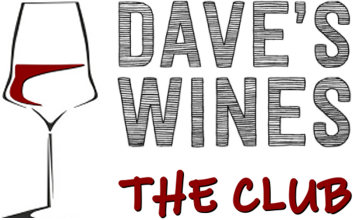




Leave a Reply